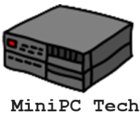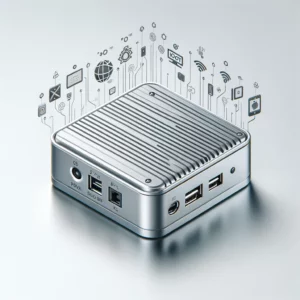
Discovering the best mini PCs for IoT projects is crucial in today’s tech-driven world. Industrial fanless mini PCs are transforming IoT applications, offering unparalleled ruggedness and efficiency. In this article, we delve into why these compact powerhouses are the ideal choice for industrial environments. We will highlight their robust design, versatile connectivity, and advanced Intel processors. Uncover the potential of these PCs in revolutionizing edge computing and IoT solutions.
Key takeaways:
- Robust and Efficient for Industrial IoT: Industrial fanless mini PCs offer unmatched ruggedness and efficiency, making them perfect for harsh environments and edge computing in IoT applications.
- Advanced Processing Power: Equipped with Intel processors, these mini PCs deliver the computing power needed for complex IoT tasks, combining high performance with energy efficiency.
- Versatile Connectivity Options: Their wide range of connectivity options ensures seamless integration into IoT systems, enhancing flexibility and functionality in various applications.
- Ideal for Harsh Conditions: The fanless design and durable construction of these mini PCs ensure reliable operation in extreme conditions, highlighting their suitability for industrial and outdoor IoT projects.
Industrial fanless mini PCs are revolutionizing IoT applications with their robust design, efficient Intel processors, and diverse connectivity. These silent, rugged units excel in harsh environments, making them ideal for edge computing and ensuring longevity. Connectivity options enable seamless integration into IoT systems, while the fanless chassis enhances reliability. Mini PCs with Intel Core processors offer formidable computing power for complex IoT tasks, combining high performance with a compact, energy-efficient form factor for versatile IoT implementations.
As a young engineer in the 80s, I was lead software engineer on the spent fuel test for Lawrence Livermore Laboratory. This used dual HP-1000 computers to monitor around 800 (more like 400 redundantly) thermocouples on a 15-30 minute timeline. HP-1000s were considered minis in those days. Because they had to run the signals from the data collectors up to the computers, they needed the redundancy. The raw data was collected and brought back to the lab for analysis.
The analogy is this. The mini PCs can act as data collectors in harsh environments. The data can then be stored and forwarded (in those days manually now electronically) to computers where the data is cleaned then analyzed.
Fast forward to the mid-2010s when I worked for a biotech startup trying to grow genetically modified bacteria. Again, we had computers monitoring different parameters of the environment. Most of the data collection was done using analog to digital sensors that were then fed into computers with GPIO interfaces. But this was not very effective in some cases. In those days the only other option was board computers like the rasberry pi, but we were a small startup and did not want to get into the business of building computers.
Computers like the ones I am reviewing might have been excellent for the first tier of a three-tier architecture; collect, gather, and analyze. Their low cost, ability to work in a harsh environment, ability to store and forward if the network went down and high speed interfaces would have vastly improved the system we were working on.
Industrial Fanless Mini PCs for IoT Applications
Industrial fanless mini PCs are revolutionizing the world of IoT applications. With their compact and rugged design, these computers offer optimal performance and reliability in industrial settings. Powered by Intel processors, they provide the necessary computing power for edge computing in IoT projects.
These mini PCs are specifically designed for industrial use, making them ideal for applications in harsh environments. Their fanless design ensures silent operation and eliminates the risk of dust and debris affecting the internal components. This level of durability allows for seamless integration into industrial IoT systems, where reliability and longevity are critical factors.
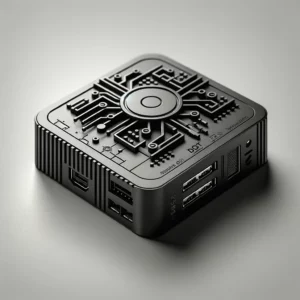
Furthermore, the industrial fanless mini PCs offer a wide range of connectivity options, enabling easy integration into existing IoT networks. Whether it’s Ethernet, Wi-Fi, Bluetooth, or USB, these PCs provide the flexibility required for various IoT applications.
In conclusion, the industrial fanless mini PCs are the best choice for IoT applications in industrial settings. Their compact size, rugged design, and superior performance make them the perfect solution for edge computing in IoT projects. Mini PCs provide a solid foundation for building robust and efficient IoT systems. This is especially true with their reliability and extensive connectivity options,
Introduction to Intel-Based Mini PCs for IoT Edge Computing
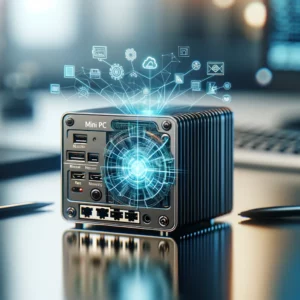
IoT applications continue to evolve and demand more powerful computing capabilities. The need for compact and efficient edge computing devices becomes imperative. Intel-based mini PCs have emerged as the best PCs for IoT edge computing. They provide a versatile solution for a wide range of applications. These mini PCs are designed to deliver high performance and power efficiency while maintaining a fanless and compact form factor.
Power and Versatility for IoT Applications
Intel-based mini PCs offer exceptional power and versatility for a variety of IoT applications. With the latest Intel processors, these mini PCs deliver superior processing performance to handle demanding tasks. Demanding tasks such as edge AI calculations and data analytics. Their compact size allows for easy integration into space-constrained environments, making them ideal for edge computing in IoT projects. Additionally, the fanless design ensures silent operation and eliminates the risk of dust and debris affecting the device’s performance. Thus, making them suitable for rugged environments.
Rugged Design for Harsh Environments
When it comes to IoT edge computing, the ability to withstand harsh environmental conditions is crucial. Intel-based mini PCs excel in this aspect, offering ruggedness and durability to thrive in challenging environments. With ruggedized enclosures and military-grade specifications, these mini PCs can withstand extreme temperatures, humidity, vibrations, and shocks. This robustness ensures reliable operation and continuous data processing in industrial settings or outdoor installations. Moreover, their fanless design eliminates the risk of fan failure due to dust or debris. This further enhances their reliability in demanding IoT applications.
Gateway Capabilities for IoT Edge Connectivity
In IoT projects, mini PCs often serve as gateways, acting as a bridge between devices and the cloud. Intel-based mini PCs provide excellent gateway capabilities. They offer various connectivity options to ensure seamless communication between edge devices and the backend infrastructure. Equipped with a myriad of ports including Ethernet, USB, HDMI, and wireless connectivity like Wi-Fi and Bluetooth, these mini PCs enable easy integration with a wide range of IoT devices. Their superior processing power and sufficient memory capacity make them capable of managing data transmission, filtering, and security protocols, making them an ideal choice for IoT gateway applications.
Choosing the Right Intel-Based Mini PC for IoT Edge Computing
Selecting the right Intel-based mini PC for your IoT edge computing project depends on several factors. Consider the specific requirements of your application, such as desired processing power, form factor, ruggedness, and connectivity options. It is also essential to evaluate the mini PC’s compatibility with your existing IoT infrastructure and software. Additionally, carefully examine the specifications and features offered by different Intel-based mini PCs. Doing so ensures they align with your project’s goals and scalability needs. By considering these aspects, you can make an informed decision and choose the best Intel-based mini PC that meets the unique demands of your IoT edge computing application.
Our Recommendations: 5 Picks for the Best Mini PCs for IoT
We picked 5 mini pcs for you. They range in price from around $175 to $450. There are more powerful ones and there are less powerful ones. Some people might like Rasberry Pi or similar single board machines, but here I have opted for Windows 11 based machines for three important reasons:
- They work out of the box. They call Rasberry Pi a “kit” for a reason. We will talk about them in another post, but here I want to focus on “drag and drop” solutions
- There are no Windows 10 or Linux solutions. I am not going to talk about them here because, Windows 10 is going away in a year according to Microsoft, and Linux is, well more than some businesses want to deal with. Probably deal with the linux boxes in another post, but too complex.
- For most industrial applications, you want to take readings then forward them on to a processor for further analysis. I worked in a biotech firm where we had a three tier system; get the data, package the data, and analyze the data. The IoT system was only the first tier. Why? Because the rest can be away from the harsh environment and can take care of multiple inputs with ease.
| Mini PC | Description | Price |
| HUNSN Fanless Industrial PC | This mid-priced Industrial Mini checks most of the boxes except the processor is a bit slow and lower disk and memory. Pricier options have more storage It has dual ethernet, supports 2 4K HDMI displays, 4 fast (3.0) and 4 slower USB (2.0) connections, 6 COM connections and dual ethernet. | CHECK PRICE ON AMAZON |
| IDEARACE Fanless Mini PC | Lower priced Mini PC with a slower processor, lower disk and memory. But it has 4 COM connections, 4 high speed USB (3.0) connections, dual ethernet, supports 1 HDMI display and 1 VGA. | CHECK PRICE ON AMAZON |
| HISTTON Fanless Mini PC | This midpriced Mini has only 2 COM connections and lower processor, disk (supports RAID) and memory, but makes up for that by supporting GPIO, supports TRIPLE 4K displays (1 DVI, 2 HDMI), 4 fast (3.0) USB, 2 COM, memory expandable to 64 GB RAM, and expandable storage. | CHECK PRICE ON AMAZON |
| MeLE PCG02 Fanless Mini PC | This is low end everything, especially the price, and it’s a stick! But it supports an HDMI, 2 fast USB (3.0), ethernet (yes from a stick). Lower memory (8 GB) and even lower disk and slow processor, but you can add storage in a micro SD slot to get it to 1TB storage (in a stick!) | CHECK PRICE ON AMAZON |
| WEIDIAN Fanless Mini PC | High end everything, including the price. high memory (16 GB expandable to 64 GB), disk (RAID!), 6 cores vs 2 to 4 for the others. Supports triple display (2 HDMI and 1 DV), GPIO, 2 COM connections, 4 high speed USB (3.0), 2 Low speed USB (2.0) | CHECK PRICE ON AMAZON |
All of these Mini PCs have a few things in common:
- Enough power to do real work
- Dual network connections, except for the stick PC – isolate your internal network from the outside world. SECURITY!!
- HDMI ports (except for the stick PC)
- Fanless – better to handle harsh industrial conditions
HUNSN Fanless Industrial PC
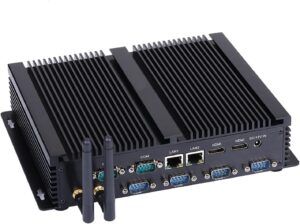
This premium unit can run Ubuntu out of the box if you’re so inclined, but can ship with Windows 11. The unit we are reviewing comes with 8GB RAM and a 256 GB SSD, which should be more than enough for many industrial applications where you just need to store and forward data. It also has dual HDMI ports which probably doesn’t matter a lot given that this is for an industrial use, but it might come in handy if you’re hooking it up to watch processes in real time.
There are multiple options available for this PC from No RAM or Storage to 8 GB RAM, 512 GB SSD and 1TB HD.
Pros:
- Good customer service
- No driver issues with clean installs
- Silent operation
Cons:
- Higher price, but with no complaints to speak of?
IDEARACE Powerful Fanless Mini PC
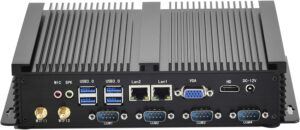
A mid-priced unit, it has a VGA and HD port so can support two monitors but not at a high resolution as the more premium units. It has dual network connections to isolate the internal and external networks. This unit has a LOT of connections including dual WIFI and LAN connections.
The Pros:
- Durable and suitable for tough environments
- Capable of upgrades and running virtual machines
The cons:
- Some people reported issues with Windows licenses and activation. Seems to me that this is a one-time issue though
HISTTON Fanless Mini PC
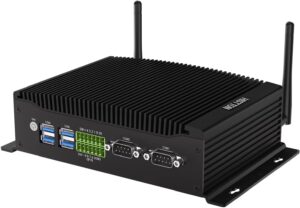
This is a higher priced PC but has features that almost none of the others can match except for the WEIDIAN (which is pricier), with 6 USB ports, support for GPIO and 4K Triple Display for process monitoring.
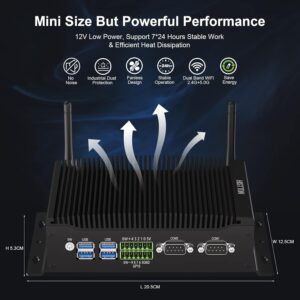
The pros:
- Lots of inputs including GPIO
- Responsive seller and good customer support – you get what you pay for!
The cons:
- a few people have reported issues like missing screws, with good customer support this should not be much of an issue
- A few people have reported overheating issues, probably means you need to provide good ventilation (this IS an industrial fanless PC!)
MeLE PCG02 Fanless Mini PC Stick
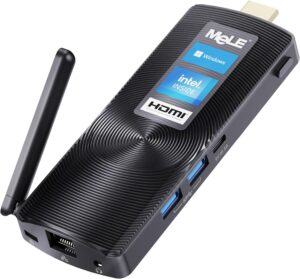
OK this has one big flaw… no second ethernet port. I think that is important for a sensor, but if space is REALLY a problem? Put it behind a firewall, access through a VLAN, etc. This is our low priced option. If you need a bunch of these, then a firewall doesn’t mean a lot in terms of cost. Another option is to use the wifi connection as the other network, but that’s not as reliable.
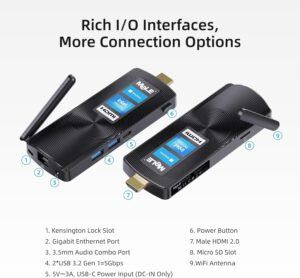
Even though this small mini pc has so many features for the price, it is limited. It only has one HDMI, one ethernet, 2 USB ports (well at least they are high speed) and a single WiFi network. But it’s TINY and inexpensive. So if price and space are important? This is a great option!
The pros:
- Small and good for specific functions
- Fanless and quiet
- Inexpensive compared to other industrial options
- Micro SD slot allows you to add an additional 1 TB of storage
The cons:
- can be slow if you try to do too much with it because of limited processor and RAM
- Fragile external antenna and subpar durability
WEIDIAN Fanless PC – Most Powerful, Most Expensive
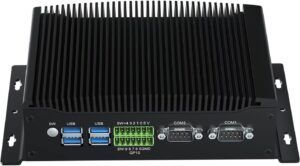
This mini comes with all of the bells and whistles of all of the other mini PCs, plus more memory (16 GB RAM), three 4K displays; 2 HDMI and one DVI.
Also has a more powerful i7 processor. All of the rest come with an older i5 or slower processor.
The network includes dual band WiFi for higher reliability networking along with the dual ethernet to allow to have separate internal and external networks as well.
It can be expanded to 64 GB of RAM.
It supports many different storage interfaces like RAID, WOL, Watch Dog, PXE, and RS485. It has a double storage design and the support of RAID makes the storage very reliable.
This machine is by far the best machine, but it comes with a price.
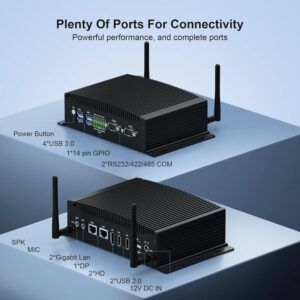
The pros:
- the specs on this blows the others out of the water. More memory, faster more reliable storage, faster processor and expandable memory and storage
The cons:
- this comes at a price
- A few people have commented that it gets hot unless you use the windows power-saving features
- May not be deliverable to some addresses (seems to not be deliverable to California, but I checked a few other states like PA, NV, OR, and WA and it seems to be deliverable there)
The Power of Rugged Mini PCs for Harsh Environments
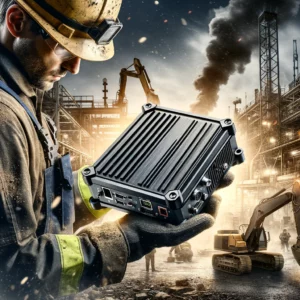
When it comes to implementing Internet of Things (IoT) projects in challenging environments, finding the right equipment is crucial for ensuring optimal performance and reliability. Rugged mini PCs emerge as the best PCs for IoT applications in such scenarios. These compact yet powerful devices are specifically designed to withstand extreme temperatures, vibrations, moisture, and dust. Thus, making them ideal for deployment in harsh environments.
Robust Design for Uncompromised Reliability
Rugged mini PCs are engineered to deliver exceptional durability even in the harshest conditions. Featuring fanless designs, these mini PCs eliminate the risk of dust accumulation or fan failure, ensuring uninterrupted operation. Their rugged enclosures are built to withstand extreme temperatures. Temperatures ranging from freezing cold to scorching heat, thus facilitating reliable performance in diverse environmental settings. Moreover, these mini PCs are constructed to resist shocks and vibrations. Thus, making them suitable for installation in industrial plants, remote sites, or outdoor locations. With Intel® Core™ processors and advanced technologies, rugged mini PCs empower IoT applications in challenging environments. They can provide seamless performance and facilitating edge computing and AI capabilities.
Powerful Mini PCs with Intel Core Processors for IoT Applications
Mini PCs equipped with Intel® Core™ i processors are considered as some of the best PCs for IoT applications that require high computing power and efficient performance. These mini PCs integrate the latest Intel processors, ensuring seamless execution of complex tasks and real-time data processing in various industrial and commercial settings.
The Intel Core processors in these mini PCs provide exceptional processing capabilities, enabling them to handle demanding IoT workloads with ease. With multiple cores and high clock speeds, these processors offer superior multitasking and rapid data analysis for IoT applications. This makes them ideal for mission-critical tasks such as real-time monitoring, data analytics, and machine learning applications in industrial automation, smart cities, and healthcare systems.
These powerful mini PCs also come with a range of connectivity options, including multiple USB ports, Ethernet ports, HDMI ports, and expansion slots, allowing easy integration with IoT devices and peripherals. The mini PC form factor makes them space-efficient and suitable for deployment in diverse environments. Whether it’s a factory floor or a remote monitoring station, these mini PCs offer the reliability, flexibility, and scalability needed to support IoT deployments.
In conclusion, the integration of Intel Core processors in mini PCs provides the necessary computing power to drive IoT applications. With their compact size, versatility, and advanced connectivity options, these mini PCs are ideally suited for various IoT projects. From industrial automation to smart city infrastructure, these powerful mini PCs can handle the demanding requirements of data processing and analysis, making them a valuable asset in the IoT ecosystem.
The Importance of Fanless Chassis in Mini PCs for IoT Solutions
Mini PCs with fanless chassis have emerged as the best PCs for IoT applications, offering reliable and efficient performance. These compact devices are equipped with advanced Intel® Core™ processors that deliver exceptional power for edge computing. With dual DDR4 slots, these mini PCs ensure faster data processing, enabling seamless connectivity and real-time analytics for IoT projects. Additionally, the fanless design eliminates the need for a cooling fan, reducing the risk of hardware failure and enhancing overall system reliability.
Enhanced Connectivity and Expandability Options
Mini PCs with fanless chassis boast a range of connectivity options that can support a variety of IoT devices and applications. Equipped with multiple USB ports, these mini PCs allow for easy integration with peripheral devices such as cameras and sensors. The inclusion of M.2 slots provides additional expansion possibilities, allowing for the installation of high-speed storage modules or wireless communication solutions. Moreover, with HDMI ports available, these mini PCs offer seamless connectivity with display devices, making them ideal for IoT edge applications where visual outputs are required for monitoring and control purposes. The combination of a fanless chassis and versatile connectivity options makes these mini PCs a reliable and flexible choice for any IoT project.
Connectivity Considerations for Mini PCs in IoT Projects
Wi-Fi and LAN Connectivity Options
When it comes to selecting the best PCs for IoT projects, connectivity plays a vital role in ensuring seamless communication between devices and systems. Mini PCs offer a range of connectivity options that are essential for successful implementation of IoT applications. One of the key considerations is the availability of Wi-Fi and LAN connectivity.
Mini PCs equipped with built-in Wi-Fi modules provide wireless connectivity, allowing devices to connect to the network without the need for physical cables. Furthermore, the inclusion of LAN ports ensures reliable and high-speed wired connections, which are particularly beneficial in scenarios where stable and secure network connections are required.
Connectivity Expansion through PCIe Slots
To accommodate various connectivity requirements in IoT projects, mini PCs often feature PCIe slots for expansion. These slots allow users to add additional features and functionalities by integrating expansion cards. PCIe slots enable the installation of diverse connectivity modules, such as graphic cards, SSDs, or LAN cards. These expansion options provide flexibility and scalability, enabling mini PCs to adapt to the evolving connectivity needs of IoT applications.
Whether it’s enhancing graphical performance, increasing storage capacity, or adding intelligent networking capabilities, the presence of PCIe slots empowers users to tailor their mini PCs to meet specific project requirements. Additionally, mini PCs with PCIe slots are compatible with various operating systems, including popular choices like Linux, providing users with a wide range of software options for their IoT compute needs.
Key Form Factors and Specifications for IoT Edge Computing
When it comes to choosing the best PCs for IoT edge computing, the form factors and specifications play a crucial role in ensuring optimal performance and reliability. One important aspect to consider is the module compatibility, allowing seamless integration with various IoT devices. Additionally, having a display port (DP) enables easy connection to 4K monitors, ensuring high-quality visuals for data analysis and visualization.
The operating system is also a significant consideration, and mini PCs running Windows 10 provide a familiar and user-friendly interface for IoT applications. Moreover, the specification of the mini PC, such as an Intel Core processor, 32GB of RAM, and a 2.5″ chassis ensure powerful and efficient performance.
Low Power Consumption and Enhanced Connectivity
A key advantage of the best mini PCs for IoT edge computing is their low power consumption, which enables energy-efficient operations. With USB 3.2 ports, users can achieve fast data transfer speeds, maximizing efficiency in IoT projects. Furthermore, the availability of multiple USB 3.2 ports, usually two or more, allows for simultaneous connections with different devices, eliminating the need for external USB hubs. This enhanced connectivity promotes seamless data flow and the ability to deliver real-time insights for IoT applications.
The mini PCs’ form factor, often compact and lightweight, enhances their versatility, making them suitable for deployment in various environments. Whether it’s deploying them in rugged or harsh environments or integrating them into existing infrastructure, these mini PCs are designed to deliver high-performance computing power with excellent reliability.
Mini PCs as Gateways in IoT Applications
Mini PCs are becoming increasingly popular as gateways in IoT applications due to their compact size, versatility, and reliable performance. These devices serve as the central hub for data collection, analysis, and communication between various IoT devices and the cloud. One of the best PCs for IoT applications is the Intel® Core™ i series fanless embedded PC powered by an Intel Atom® or Xeon® processor. This powerful combination ensures seamless data processing and enables edge AI capabilities for real-time decision-making.
In addition to their processing power, mini PCs designed for IoT gateways also offer a wide range of connectivity options. With interfaces such as Ethernet, USB, HDMI, and wireless connectivity options like Wi-Fi and Bluetooth, these devices can easily connect to a myriad of peripherals and sensors. This enables them to collect data from multiple sources and transmit it securely to the cloud for analysis. Moreover, mini PCs with fanless chassis are suitable for harsh environments, operating flawlessly even at temperature extremes of up to 50°C. Their rugged design ensures dependable performance, making them ideal for IoT projects in various industries.
With the increasing demand for IoT applications, mini PCs as gateways provide a reliable and efficient solution. These devices offer robust processing capabilities, connectivity options, and durability required for successful implementation of IoT projects. Furthermore, mini PCs with Intel® Core™ i processors and fanless chassis ensure optimal performance and longevity.
As technology continues to evolve, these compact yet powerful devices will play a crucial role in shaping the future of IoT applications.
Connectivity Options for Your IoT Project
In the evolving landscape of the Internet of Things (IoT), choosing the right mini PC for your project is crucial. The best PCs for IoT should offer a wide range of connectivity options to suit the unique requirements of different applications. Whether it’s for industrial settings in Industry 4.0 or real-time machine vision tasks, connectivity options may vary.
It’s essential to consider factors such as data transfer speeds, network compatibility, and the ability to connect to a variety of IoT devices. Some mini PCs come equipped with advanced connectivity features like AMD processors, which provide enhanced performance for demanding IoT workloads. Additionally, with emerging technologies such as Windows 11 and DDR5 memory, the connectivity capability of mini PCs is further elevated, ensuring seamless integration into the interconnected world of IoT.
Micro PCs with Intel® Core™ Processors and Dual Channel DDR5 for Enhanced Performance
When it comes to mini PCs for IoT projects, the usage scenarios can be diverse. These scenarios range from simple monitoring applications to complex data processing tasks. In such cases, having a mini PC that possesses the capability to handle the workload efficiently is essential. This is where the 12th Gen Intel® Core™ processors excel. These powerful processors offer remarkable performance and enable real-time processing for time-critical applications in the IoT realm.
Furthermore, mini PCs equipped with dual-channel DDR5 memory can enhance data transfer speeds and enable smoother multitasking capabilities, making them perfect for machine vision applications or other computationally intensive IoT tasks. By leveraging the advanced features of these micro PCs, you can ensure that your IoT project operates seamlessly and delivers consistent performance.
Mini PCs are quickly becoming the best PCs for IoT projects, offering a wide range of features and capabilities. These compact devices are designed with a fan-less chassis for efficient heat dissipation, ensuring reliable operation in various environments. With extended temperature and durability, mini PCs, such as the X series, can withstand harsh conditions and provide uninterrupted performance. Additionally, the integration of WiFi 6 enables seamless connectivity, allowing for real-time data transmission and secure communication between devices.
In terms of processing power, mini PCs are equipped with high-performance mobile processors that ensure optimal productivity in IoT applications. These processors, combined with optional memory configurations, such as DDR4 memory, offer versatility and flexibility in system configuration. Moreover, mini PCs come equipped with smart protection features to ensure data security and prevent unauthorized access. Mini PCs are the ideal choice for IoT projects that require efficient and reliable computing power. Especially with their small form factor and powerful capabilities.
Choosing the Ideal Mini PC for IoT: A Conclusion on Performance and Reliability
The journey to find the best mini PC for IoT applications leads us to the remarkable world of industrial fanless mini PCs. These devices stand out with their robust design, exceptional processing power, and versatile connectivity options. Thus, making them ideal for the demanding requirements of IoT edge computing. Whether it’s for industrial automation, smart city infrastructure, or rugged outdoor applications, these mini PCs prove to be reliable, efficient, and indispensable tools. Embracing these technological marvels can significantly enhance the performance and scalability of IoT projects, paving the way for a more connected and efficient future.
| Mini PC | Description | Price |
| HUNSN Fanless Industrial PC | This mid-priced Industrial Mini checks most of the boxes except the processor is a bit slow and lower disk and memory. Pricier options have more storage It has dual ethernet, supports 2 4K HDMI displays, 4 fast (3.0) and 4 slower USB (2.0) connections, 6 COM connections and dual ethernet. | CHECK PRICE ON AMAZON |
| IDEARACE Fanless Mini PC | Lower priced Mini PC with a slower processor, lower disk and memory. But it has 4 COM connections, 4 high speed USB (3.0) connections, dual ethernet, supports 1 HDMI display and 1 VGA. | CHECK PRICE ON AMAZON |
| HISTTON Fanless Mini PC | This midpriced Mini has only 2 COM connections and lower processor, disk (supports RAID) and memory, but makes up for that by supporting GPIO, supports TRIPLE 4K displays (1 DVI, 2 HDMI), 4 fast (3.0) USB, 2 COM, memory expandable to 64 GB RAM, and expandable storage. | CHECK PRICE ON AMAZON |
| MeLE PCG02 Fanless Mini PC | This is low end everything, especially the price, and it’s a stick! But it supports an HDMI, 2 fast USB (3.0), ethernet (yes from a stick). Lower memory (8 GB) and even lower disk and slow processor, but you can add storage in a micro SD slot to get it to 1TB storage (in a stick!) | CHECK PRICE ON AMAZON |
| WEIDIAN Fanless Mini PC | High end everything, including the price. high memory (16 GB expandable to 64 GB), disk (RAID!), 6 cores vs 2 to 4 for the others. Supports triple display (2 HDMI and 1 DV), GPIO, 2 COM connections, 4 high speed USB (3.0), 2 Low speed USB (2.0) | CHECK PRICE ON AMAZON |
Frequently Asked Questions
What makes a mini PC ideal for IoT applications?
Mini PCs are ideal for IoT applications due to their compact size, low power consumption, robust processing capabilities, and versatile connectivity options, making them perfect for edge computing and data processing in various environments.
Can mini PCs handle the processing demands of IoT projects?
es, the best mini PCs for IoT are equipped with powerful processors, such as Intel Core series, capable of handling complex computations and multitasking required in IoT projects, including real-time data analysis and edge AI applications.
How do fanless mini PCs benefit IoT deployments?
Fanless mini PCs offer the advantage of silent operation, reduced dust accumulation, and enhanced reliability in harsh environments, making them particularly suitable for industrial IoT applications where durability and uninterrupted operation are critical.
What connectivity options do mini PCs offer for IoT setups?
Mini PCs provide a wide range of connectivity options, including Ethernet, Wi-Fi, Bluetooth, and multiple USB ports, facilitating seamless integration with IoT devices, sensors, and networks for comprehensive IoT solutions.
Are mini PCs suitable for outdoor IoT applications?
Many mini PCs are designed with rugged, durable enclosures and can operate in extreme temperatures, making them suitable for outdoor IoT applications in challenging conditions, including remote monitoring and smart city infrastructure.
How do I choose the best mini PC for my IoT project?
When choosing a mini PC for IoT, consider the processing power, memory and storage capacity, connectivity options, and the operating environment’s specific requirements. Look for devices with robust processors, sufficient RAM and storage for your application, and the necessary ports and wireless capabilities to connect your IoT devices. Additionally, factor in the device’s durability and resistance to environmental conditions if deploying in harsh settings.

I am a retired software engineer with experience in a multitude of areas including managing AWS and VMWare development environments. I bought a relative a mini-PC a year ago and have become passionate about the technology and its potential to change how we deploy software.
